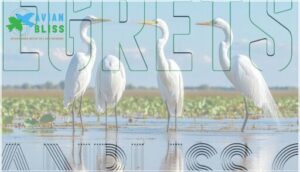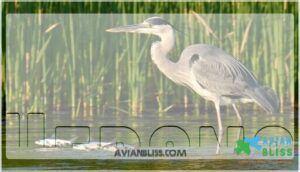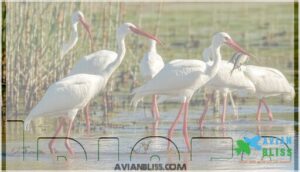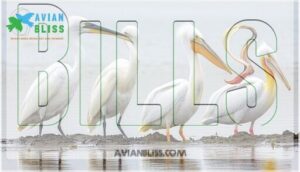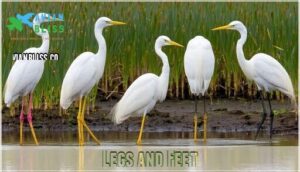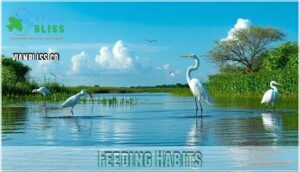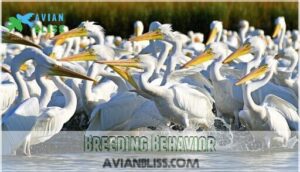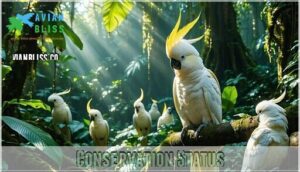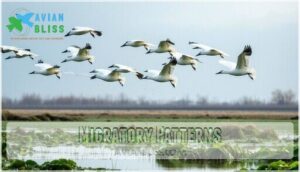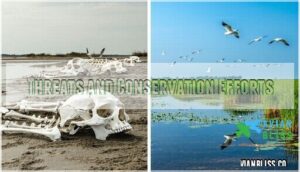This site is supported by our readers. We may earn a commission, at no cost to you, if you purchase through links.

You’ll encounter stunning species like Great Egrets, Snowy Egrets, Great Blue Herons, and American White Pelicans across marshes, lakes, and coastal areas.
These magnificent hunters possess specialized bills for catching fish, long legs for wading, and pristine white plumage that serves as both camouflage and courtship display.
They’re patient stalkers who can stand motionless for hours before striking with lightning speed.
Most species nest in colonies, creating spectacular breeding displays during spring.
From backyard ponds to vast estuaries, these graceful creatures transform ordinary waterways into wildlife theaters.
Understanding their feeding patterns and seasonal movements reveals incredible birdwatching opportunities.
Table Of Contents
- Key Takeaways
- Types of White Water Birds
- Physical Characteristics of White Water Birds
- Habitat and Distribution
- Feeding Habits
- Breeding Behavior
- Conservation Status
- Adaptations for Aquatic Life
- Migratory Patterns
- Cultural Significance
- Threats and Conservation Efforts
- Frequently Asked Questions (FAQs)
- What are the different types of white birds?
- Are there white birds in the wild?
- How many types of white birds are there in North America?
- What birds live in water?
- What color is a water bird?
- Why are water birds white?
- What are the white birds around the water?
- Are egret and heron the same?
- What are the white birds at the beach called?
- What is a white billed water bird?
- Conclusion
Key Takeaways
- You’ll find diverse white water birds across wetlands worldwide – from Great Egrets with yellow beaks to American White Pelicans with massive pouches, each species has specialized bills and legs perfectly adapted for hunting fish, crustaceans, and insects in their aquatic environments.
- These birds create spectacular breeding colonies during spring – you can witness elaborate courtship displays as hundreds gather together, with Great Egrets growing ornate plumes and engaging in synchronized dances to attract mates and establish pair bonds.
- They’re master hunters with lightning-fast strike techniques – you’ll observe them standing motionless for hours before striking with incredible speed, using specialized hunting strategies like cooperative fishing in pelicans or stirring sediment with their feet like Snowy Egrets.
- Conservation efforts have successfully restored many populations – while species like Great Egrets recovered from near-extinction after plume trade protections, you should know that habitat loss and climate change still threaten these magnificent birds, making wetland protection crucial for their survival.
Types of White Water Birds
You’ll encounter four main groups of white water birds during your birdwatching adventures: egrets, herons, ibises, and pelicans.
Each group has distinct characteristics, from the elegant long necks of egrets and herons to the curved bills of ibises and the massive pouched beaks of pelicans.
Egrets
Four stunning egret species showcase remarkable diversity in white water birds.
You’ll spot these elegant wading birds through distinctive plumage variation and unique egret behavior patterns.
These graceful hunters showcase nature’s artistry through snow-white feathers and mesmerizing stalking techniques.
- Great Egret: Develops spectacular breeding plumes and emits loud croaking egret sounds
- Snowy Egret: Features bright yellow feet for prey detection and creates egret hybrids
- Cattle Egret: Displays golden breeding feathers with distinctive calls
- Little Blue Egret: Shows white juvenile plumage before blue transformation
Herons
While egrets grab attention with their snowy plumage, herons showcase incredible diversity in white water bird species. Great Blue Herons display stunning all-white subspecies in Florida, while Little Blue Heron juveniles start completely white before developing their signature blue coloring.
Heron Identification becomes easier when you understand their unique characteristics:
- Behavior: They freeze motionless before lightning-quick strikes at prey
- Communication: Deep croaks and harsh squawks echo across wetlands
- Social Hierarchy: Larger birds dominate prime fishing spots through intimidation
- Hunting Techniques: Patient wading combined with explosive neck strikes
- Heron Habitats: From shallow marshes to coastal estuaries and freshwater ponds
Heron Diet consists primarily of fish, frogs, and crustaceans. Heron Conservation efforts focus on protecting wetland habitats essential for their survival.
Ibises
Moving beyond herons, you’ll encounter the remarkable White Ibis with its distinctive curved orange beak.
These aquatic birds showcase fascinating Ibis Behavior through their probing feeding style.
White water birds like these demonstrate unique Ibis Diet preferences:
- Crayfish and crabs – their primary protein sources
- Small fish – caught in shallow waters
- Insects – supplementing their varied nutrition
Their pure Ibis Plumage makes identification straightforward.
Pelicans
In the context of spectacular white water birds, pelicans reign supreme with their massive wingspans and distinctive pelican pouches.
You’ll spot the American White Pelican‘s cooperative fishing techniques as flocks work together to corral fish. These remarkable water birds showcase fascinating pelican behavior during pelican migration seasons.
Here’s what makes pelicans extraordinary:
- Pouches hold up to 3 gallons of water
- Cooperative fishing in coordinated groups
- 9-foot wingspans for effortless soaring
Pelican conservation efforts continue protecting these majestic birds.
Physical Characteristics of White Water Birds
You’ll notice that white water birds share specific physical traits that help them thrive in aquatic environments.
These birds typically display pristine white plumage, specialized bills for catching prey, and long legs adapted for wading through shallow waters.
Plumage
You’ll discover fascinating plumage variations among white water birds that make identification exciting.
These stunning creatures showcase remarkable feather transformations throughout their lives.
- Breeding Plumage: Great Egrets develop elegant plumes during mating season, while Cattle Egrets display golden patches on their backs and chests.
- Juvenile Plumage: Little Blue Herons start completely white before developing their signature blue coloration as adults.
- Color Morphs: Snow Geese exhibit two distinct forms – pure white and blue-gray variations within the same species.
Bills
White water birds showcase remarkable bill morphology that defines their hunting prowess.
These specialized bills serve as precision tools, each feeding adaptation perfectly matched to their prey. Bill coloration varies dramatically across species, while bill function determines survival success.
- Snowy Egret: Razor-sharp black dagger for lightning-fast fish strikes
- White Ibis: Curved orange probe for muddy bottom exploration
- American White Pelican: Massive yellow scoop with expandable pouch
- Cattle Egret: Compact yellow spear for insect capture
Perfect bird identification starts with recognizing these distinctive features.
Legs and Feet
You’ll notice that legs and feet reveal everything about how white water birds master their aquatic world. These specialized appendages serve as both hunting tools and mobility systems perfectly adapted to wetland life.
Foot coloration varies dramatically across species, while leg length determines feeding depth preferences. Many water birds feature webbed feet for swimming efficiency, though wading species prioritize stalking adaptations instead.
Key leg and foot characteristics include:
- Bright yellow feet enhance prey attraction (Snowy Egret)
- Pink-red curved claws improve grip (White Ibis)
- Short dark legs optimize terrestrial foraging (Cattle Egret)
- Yellowish-green elongated limbs enable deep wading (Little Blue Heron)
- Bi-colored feet provide camouflage advantages (Reddish Egret)
The unique characteristics of legs and feet, such as hunting tools and specialized features, are crucial for the survival of water birds in their environment.
Habitat and Distribution
You’ll find white water birds across nearly every continent, from North American wetlands and coastal areas to freshwater lakes and saltwater estuaries worldwide.
These adaptable species thrive in diverse environments, including marshes, ponds, rivers, and shallow bays, with some populations migrating seasonally between breeding grounds in northern regions and wintering areas along southern coastlines, which is a result of their ability to live in freshwater lakes and saltwater estuaries.
North and South America
Across North and South America, you’ll find incredible regional variations among white water birds.
From Arctic tundra to tropical wetlands, these North American species have adapted to diverse climates.
American White Pelican populations thrive in northern lakes, while Snowy Egrets dominate southern coastlines.
Bird sanctuaries protect critical habitats, though invasive species and climate impacts pose ongoing challenges.
Vultures also play a role by providing ecosystem sanitation through carrion consumption.
Conservation successes include recovering Great Egret populations, proving that dedicated protection efforts can restore these magnificent white birds throughout water bird habitats, and highlighting the importance of ecosystem sanitation and bird sanctuaries in maintaining diverse climates.
Worldwide
You’ll find white water birds scattered across every continent except Antarctica, showcasing remarkable Global Distribution and Species Diversity.
These white birds navigate complex Migratory Routes spanning thousands of miles, while Introduced Species like Cattle Egrets have successfully colonized new territories.
Their white plumage makes bird identification easier, though Conservation Challenges threaten many populations through habitat loss and climate change impacts.
Many species display key water bird adaptations like webbed feet for swimming.
Coastal Areas
Coastal habitats serve as essential sanctuaries where white water birds flourish along shorelines worldwide.
These dynamic environments support diverse seabirds with white plumage through saltwater feeding opportunities and protected nesting sites.
However, human impact threatens these delicate ecosystems:
- Rising sea levels reshape traditional roosting areas
- Pollution contaminates feeding grounds
- Development fragments critical bird migration corridors
Feeding Habits
You’ll find that white water birds have developed specialized feeding strategies to catch fish, insects, and crustaceans in their aquatic environments.
These birds use techniques like patient stalking, cooperative hunting, and stirring water with their feet to locate and capture prey efficiently.
Fish
Fish consumption drives the hunting behavior of white water birds like herons and egrets.
These skilled predators use specialized fishing techniques, striking with lightning speed when fish abundance peaks.
You’ll observe their patient stalking in shallow waters, where fish diversity and fish size determine their success.
Their sharp bills perfectly match their bird diet needs, making water birds incredibly efficient fishers, with lightning speed being a key factor in their hunting behavior.
Insects and Crustaceans
Beyond fish, you’ll find white water birds actively hunting insects and crustaceans with remarkable Foraging Techniques.
This behavior is characterized by a specific Prey Preference that varies by species – Snowy Egrets use their golden feet to stir sediment, while White Ibis probe mud with curved bills.
The Diet Composition of these birds includes beetles, dragonflies, and crayfish, showcasing impressive Crustacean Variety that supplements their nutritional needs perfectly.
Breeding Behavior
You’ll witness remarkable breeding displays when white water birds gather in massive colonies during spring and summer months.
These species perform intricate courtship rituals, from Great Egrets growing elaborate plumes to attract mates, to American White Pelicans developing distinctive horn-like projections on their bills.
Nesting in Colonies
White water birds create impressive colonies where hundreds gather to breed.
You’ll witness remarkable teamwork as these bird colonies establish social hierarchy through strategic positioning. Colony size varies dramatically – some host thousands of nests within acres.
To guarantee the colony’s success, consider purchasing essential bird supplies.
- Nest materials: Sticks, reeds, and aquatic vegetation carefully woven together
- Chick development: Both parents share feeding duties for faster growth
- Predator defense: Group vigilance protects vulnerable bird nests effectively
- Social hierarchy: Dominant pairs claim prime waterfront real estate first
Elaborate Courtship Displays
Beyond their colonial nesting habits, white water birds captivate with spectacular mating rituals.
You’ll witness Great Egrets performing intricate dance displays while showcasing ornate plume displays during breeding season.
Vocalizations intensify as pairs engage in synchronized movements, establishing vital pair bonding.
These elaborate bird breeding behaviors demonstrate how plumage and bird behavior work together, ensuring water birds successfully attract mates through mesmerizing courtship performances.
Conservation Status
You’ll find that most white water birds maintain stable populations, with species like Great Egrets and Snowy Egrets classified as Least Concern after recovering from near-extinction in the early 1900s.
However, you should know that some species face serious threats, including the Whooping Crane which remains critically endangered with only 600 individuals despite decades of conservation efforts.
Least Concern
Most white birds like Great Egrets and Cattle Egrets enjoy Least Concern status due to their Adaptive Success and Habitat Expansion.
These resilient water birds show positive Population Trends with Minimal Threats affecting their survival.
Their ability to thrive in diverse bird habitats despite some Human Impact demonstrates remarkable bird behavior that ensures stable populations across multiple bird species.
The Great Egret’s populations remarkably rebounded after protections from the plume trade.
Vulnerable
Several white birds face serious threats from habitat loss, climate change, and pollution impact.
You’ll find water birds like certain heron species experiencing population decline despite ongoing conservation efforts.
These endangered species require immediate attention through targeted conservation strategies and bird conservation programs.
Protecting wetland ecosystems becomes essential for maintaining stable populations of these vulnerable species.
Adaptations for Aquatic Life
You’ll notice that white water birds have developed remarkable physical features that help them thrive in aquatic environments.
Their specialized bills, webbed or semi-webbed feet, and waterproof feathers work together to make them efficient hunters and swimmers in wetland habitats.
Webbed Feet
You’ll notice that webbed foot propulsion gives water birds their swimming advantage.
This foot morphology creates paddle-like surfaces that push against water with remarkable swimming efficiency.
Evolutionary advantages include enhanced maneuverability and speed when chasing prey.
Aquatic birds display webbed foot variations – from partial webbing in herons to full webbing in waterfowl, optimizing their diving and surface swimming abilities.
Specialized Bills
Beyond webbed feet, bill morphology reveals nature’s engineering genius in white water birds.
Each species variation represents millions of years of evolutionary pressures shaping feeding adaptations. You’ll discover how bill function determines survival success in aquatic environments.
Bird anatomy showcases remarkable diversity through specialized bills designed for specific bird feeding strategies:
- Snowy Egrets wield razor-sharp black daggers to spear fish with lightning precision
- White Ibises probe muddy bottoms using curved orange bills like surgical instruments
- American White Pelicans deploy massive pouched bills as living fishing nets
- Great Egrets strike with yellow spears perfectly balanced for underwater hunting
Migratory Patterns
You’ll find that white water birds display fascinating movement patterns throughout the year, with some species traveling thousands of miles while others remain in the same area year-round.
These migration behaviors depend on factors like food availability, breeding requirements, and seasonal weather changes, creating distinct patterns you can observe and predict.
Partial Migrants
Migration triggers determine which white birds set out on seasonal journeys while others stay put.
You’ll notice that partial migrants respond differently to climate impacts and food availability.
Some water birds from the same species migrate to wintering areas while their neighbors remain year-round residents.
This fascinating behavior affects breeding success and stopover ecology patterns.
| Species | Migration Pattern | Primary Trigger |
|---|---|---|
| Snowy Egret | Northern populations migrate | Temperature drops |
| Great Egret | Varies by region | Food scarcity |
| Cattle Egret | Follows livestock movements | Resource availability |
| White Ibis | Coastal populations move inland | Seasonal flooding |
Understanding these bird migration patterns helps predict bird populations’ movements across different habitats, influenced by climate impacts and food availability.
Resident Species
Unlike seasonal visitors, these white water birds claim permanent residence in their chosen territories.
You’ll find these breeding residents maintaining year-round presence in local habitats, creating stable population dynamics that benefit conservation impact efforts.
Many species rely on visual landmarks during their travels.
- Snowy Egret: Coastal marshes across North and South America
- Cattle Egret: Open fields and wetlands worldwide
- White Ibis: Southeastern US coastal regions
- American White Pelican: Southeastern waters, expert fish divers
Cultural Significance
You’ll discover that white water birds hold deep spiritual meaning across many cultures, representing purity, peace, and divine connection in religious traditions worldwide.
Native American tribes particularly revere species like the Great Egret and Whooping Crane as sacred messengers, incorporating their symbolism into ceremonies, storytelling, and traditional art forms that continue today.
Symbols of Purity and Spirituality
You’ll find white water birds serving as spiritual messengers across countless cultures worldwide.
Their pristine plumage represents divine purity, while their graceful movements embody tranquility and enlightenment.
Religious significance appears in Christianity, where herons symbolize Christ’s patience, and in Eastern traditions celebrating cranes as longevity symbols.
Cultural symbolism transforms these magnificent creatures into powerful bird deities representing wisdom and spiritual awakening.
Revered in Native American Cultures
Throughout Native American cultures, white water birds carry profound Sacred Birds status in Tribal Lore and Creation Stories.
You’ll discover that herons and egrets held special Ceremonial Use in Cherokee rituals, where their pristine feathers adorned warriors and peace ceremonies.
These water birds embody Symbolic Meanings of purity and spiritual connection, with the Great White Heron’s wings serving as ancient peace emblems across tribes.
The great egret’s distinctive breeding plumage further enhanced their symbolic value, highlighting the importance of these birds in Native American cultures, particularly in relation to spiritual connection.
Threats and Conservation Efforts
You’ll discover that white water birds face serious challenges from wetland destruction, pollution, and climate change that reduce their feeding and nesting areas.
Conservation programs now protect critical habitats, regulate hunting seasons, and monitor populations to guarantee these elegant species survive for future generations, which is crucial for their survival.
Habitat Loss and Degradation
Wetland destruction threatens white water birds across the globe, with 84% of China’s endangered species facing habitat loss.
Pollution impacts contaminate their food sources while climate change alters migration routes.
Invasive species crowd out native wetlands where these magnificent white birds nest and feed.
Effective conservation strategies include wetland restoration, pollution control, and habitat protection to guarantee bird conservation success. These strategies often require specialized restoration products.
Hunting and Poaching
Beyond habitat destruction, hunting and poaching have devastated white water bird populations for centuries.
The feather trade nearly wiped out Great Egrets and Snowy Egrets in the early 1900s when their plumes adorned fashionable hats.
Illegal hunting continues threatening species like Wood Storks and Whooping Cranes, while egg collection disrupts breeding colonies.
Poisoning threats from lead ammunition and pesticides compound these conservation impacts.
Bird conservation organizations now combat these bird threats through advanced surveillance, stricter penalties, and community education.
Bird protection efforts focus on:
- Night vision cameras monitoring nesting colonies
- Undercover operations targeting illegal traders
- Heavy fines deterring would-be poachers
- Educational programs in local communities
- Rehabilitation centers for injured birds
- International treaties protecting migratory species
- Reward systems for reporting violations
- Alternative livelihood programs for former hunters
- Habitat restoration following enforcement actions
- Scientific research tracking population recovery
Bird conservation history shows enforcement works when combined with public awareness campaigns.
These efforts are essential, as agriculture impacts 73% of threatened species.
Frequently Asked Questions (FAQs)
What are the different types of white birds?
You’ll encounter various white bird species including Great Egrets with yellow beaks, Snowy Egrets with black bills, Cattle Egrets, White Ibis with curved beaks.
Snow Geese, Tundra Swans, and American White Pelicans can also be found across different habitats.
Are there white birds in the wild?
Like scattered pearls across nature’s canvas, you’ll discover numerous white birds thriving in the wild.
Great egrets, snowy egrets, whooping cranes, and wood storks grace wetlands worldwide, proving white plumage isn’t just captive beauty, with white birds being a common sight.
How many types of white birds are there in North America?
You’ll find dozens of white bird species across North America, including Great Egrets, Snowy Egrets, American White Pelicans, Trumpeter Swans, Snow Geese, and Wood Storks.
Each of these species has unique characteristics and habitats.
What birds live in water?
What feathered creatures call aquatic homes their own?
You’ll spot herons, egrets, pelicans, swans, geese, ducks, and cormorants thriving in wetlands.
These birds hunt fish, nest near shores, and’ve mastered life between water and sky.
What color is a water bird?
Water birds display a stunning spectrum of colors – you’ll spot brilliant white egrets and swans, deep blue herons, black cormorants, brown ducks, and even pink flamingos.
Each is adapted perfectly to their aquatic environments.
Water birds display a range of colors including pink flamingos.
Why are water birds white?
Many theories suggest white feathers help you blend with sky reflections on water surfaces.
You’ll find this camouflage gives hunting birds like egrets and herons a tactical advantage when stalking fish below.
What are the white birds around the water?
You’ll spot Great Egrets with their elegant yellow beaks, Snowy Egrets flashing golden feet, and graceful swans gliding silently.
These stunning white species thrive near ponds, marshes, and coastlines throughout North America.
Are egret and heron the same?
Scientists classify both egrets and herons in the same Ardeidae family – they’re basically cousins.
You’ll notice egrets are typically smaller with pure white plumage, while herons come in various colors and sizes.
What are the white birds at the beach called?
You’ll typically see Great Egrets, Snowy Egrets, and Cattle Egrets at beaches.
These elegant white wading birds hunt for fish, crabs, and small creatures in shallow coastal waters and sandy shorelines.
What is a white billed water bird?
You’ll likely see a white ibis, which sports a distinctive long, curved orange or pinkish bill.
These wading birds use their specialized beaks to probe mud and shallow water for crabs, fish, and insects.
Conclusion
Like silent sentinels guarding nature’s waterways, white water birds represent some of our planet’s most remarkable aquatic adaptations.
You’ve discovered twenty-five species that transform ordinary wetlands into extraordinary wildlife spectacles.
These elegant hunters face mounting pressures from habitat loss and climate change, making your awareness essential for their survival.
Whether you’re planning your next birding adventure or simply appreciating these magnificent creatures from afar, remember that every observation contributes to their conservation story and helps in their overall survival.
- https://myfwc.com/wildlifehabitats/profiles/birds/waterbirds/white-ibis/
- https://mdc.mo.gov/discover-nature/field-guide/american-white-pelican
- https://www.birdsandblooms.com/birding/attracting-birds/bird-nesting/bird-nesting-season-great-egrets/
- https://www.audubon.org/
- https://avianres.biomedcentral.com/articles/10.1186/s40657-018-0106-9

